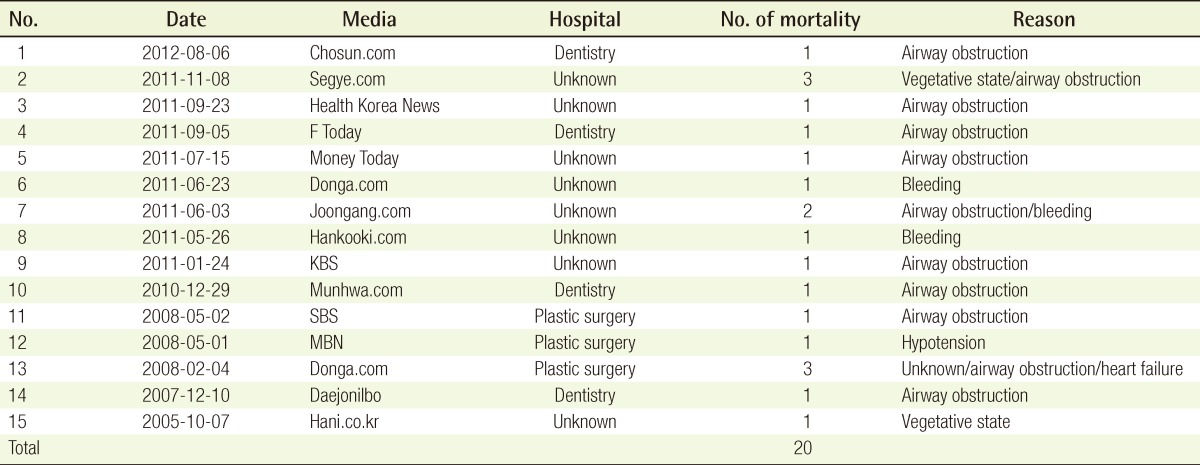Postoperative Monitoring Following Jaw Surgery Is Essential
Article information
Though there are no available statistics, about 5,000 cosmetic jaw operations seem to be performed yearly in South Korea [1]. The frequency of jaw surgery is increasing in South Korea and in the United States. Recently, serious complications, including mortality, have been reported in the mass media.
An editorial of a Korean daily newspaper insisted that the Korean Medical Association and the authorities have a certification system, which includes regulation that hospitals and clinics, with expertise and proficiency only, can perform jaw surgery and regulate unwarranted advertisement for surgery.
In the literature, 32% to 52% of the patients who underwent jaw surgery had sensory disturbances and 17% had respiratory disturbances [2,3]. No cases of mortality have been reported in any scientific papers; however, articles on cases of mortality due to jaw surgery have been found in several newspapers (Appendix 1).
We searched for mortality cases after jaw surgery via an internet search. The search keywords were: orthognathic, maxillofacial, jaw, surgery, die, death, and mortality. Among 5,000 cases, there were 20 cases (0.4%) of serious complications after jaw surgery. We found 17 cases of mortality and 3 cases of patients in a vegetative state after jaw surgery. Among the 20 cases of serious complications, 15 (75%) were caused by airway obstruction, followed by 3 (15%) caused by bleeding, 1 (5%) caused by hypotension, and 1 of unknown cause (Tables 1, 2).
Respiratory insufficiency after jaw surgery is due to airway obstruction that results from edema of the respiratory tract. Because the upper jaw and lower jaw are fixed by intermaxillary fixation after jaw surgery, the patients cannot expectorate sputum easily. Jaw surgery for prognathia has a risk of negative pressure pulmonary edema because it makes a patient's upper airway space narrower by moving the lower jaw backwards. Bleeding and swelling in the oral cavity also make the airway space narrower. In addition, oozing from the wound sometimes irritates the patient's larynx and might initiate laryngospasm [4,5].
In order to maintain a patent airway, the following standards should be met: 1) Pulse oximeter is essential. Oxygen saturation decreases 1 minute after airway obstruction. Therefore, immediate treatment is needed when a decrease in oxygen saturation is observed. 2) Capnography, the monitoring of the concentration or partial pressure of carbon dioxide (CO2) in the respiratory gases, may be very effective. It is direct monitoring of the exhaled concentration of CO2. A sudden drop in the CO2 level during the postoperative period can be detected. 3) Fully equipped and readily available suction, epinephrine spray, intubation, and tracheostomy sets should be prepared at the bedside. A mildly humid atmosphere should be kept. 4) Surgeons or anesthesiologists should be present at all times.
In a hypoxic state, the following standards should be met: 1) Check whether the patient is breathing well or not. 2) Encourage deep breathing. 3) Give oxygen at 3 to 5 L per minutes via a mask. 4) If oxygen saturation drops below 80%, insert a nasal airway. 5) If cyanosis or tachycardia appears, remove the intermaxillary fixation and perform intubation. 6) If intubation fails or bradycardia appears, carry out tracheostomy immediately.
Acknowledgements
We are grateful to Ms. Se Won Hwang, Medical Student, Peninsula Medical School, Exeter, UK, for her help in making revisions and to Professor Hong Sik Kim, MD, PhD, Department of Anesthesiology, Inha University Hospital, for his advice on airway management.
Notes
No potential conflict of interest relevant to this article was reported.
Appendices
Appendix 1
Kim HJ. Wrong prescription of jaw surgery causes serious side effects. Segye.com [Internet]. 2011 Nov 18 [cited 2012 Nov 1]; Medical and health. Available from: http://www.segye.com/Articles/NEWS/CULTURE/Article.asp?aid=20111118004334&subctg1=&subctg2=.
Lee DK. If you need jaw surgery, you must visit the dentist first. Healthkoreanews [Internet]. 2011 Sep 23 [cited 2012 Nov 1]; Dental. Available from: http://www.hkn24.com/news/articleView.html?idxno=81975.
Ann HJ. Both sides of jaw surgery. Financial today [Internet]. 2011 Sep 5 [cited 2012 Nov 1]; Society. Available from: http://www.ftoday.co.kr/news/articleView.html?idxno=6106.
Choi EM. Serious side effects caused by indiscriminate jaw surgery. Moneytoday [Internet]. 2011 Jul 15 [cited 2012 Nov 1]; Health. Available from: http://www.mt.co.kr/view/mtview.php?type=1&no=2011070810024396272&outlink=1.
Lee JH. This is a complex surgery. Donga.com [Internet]. 2011 Jun 23 [cited 2012 Nov 1]; Broadcasting. Available from: http://news.donga.com/3/all/20110623/38239635/5.
Moneytoday. Jaw surgery craze. Moneytoday [Internet]. 2011 Jun 3 [cited 2012 Nov 1]; Health. Available from: http://news.mt.co.kr/mtview.php?no=2011060308321362161&type=1.
Kwon D. Jaw surgery, Series of medical accidents such as excessive bleeding. Hankooki [Internet]. 2011 May 26 [cited 2012 Nov 1]; Society. Available from: http://news.hankooki.com/lpage/health/201105/h2011052602305184500.htm.
Park DG. Attention, jaw surgery. Korea broadcasting system [Internet]. 2011 Jan 24 [cited 2012 Nov 1]; Life. Available from: http://news.kbs.co.kr/science/2011/01/24/2231965.html.
Park JH. Surgery without emergency equipment, the doctor's negligence. Munhwa.com [Internet]. 2010 Dec 29 [cited 2012 Nov 1]; Society. Available from: http://media.daum.net/society/others/newsview?newsid=20101229141110959.
Seoul Broadcasting System. Women have died in jaw surgery. SBS [Internet]. 2008 May 2 [cited 2012 Nov 1]; Society. Available from: http://news.sbs.co.kr/section_news/news_read.jsp?news_id=N1000411611.
MBN. Women have died in jaw surgery. MBN [Internet]. 2008 May 1 [cited 2012 Nov 1]; Society. Available from: http://mbn.mk.co.kr/pages/news/newsView.php?news_seq_no=343403.
Han SJ. Women have died after jaw surgery. Donga.com [Internet]. 2008 Feb 4 [cited 2012 Nov 1]; Society. Available from: http://news.donga.com/3/all/20080204/8541147/1.
Daejonilbo. Scared to go to the hospital. Daejonilbo [Internet]. 2007 Dec 10 [cited 2012 Nov 1]; Society. Available from: http://news.naver.com/main/read.nhn?mode=LSD&mid=sec&sid1=102&oid=089&aid=0000129276.
Kim YH. Women in their 20s before marriage, died after jaw surgery. Hankyoreh [Internet]. 2005 Oct 7 [cited 2012 Nov 1]; Society. Available from: http://www.hani.co.kr/kisa/section-002002000/2005/10/002002000200510071501739.html.

